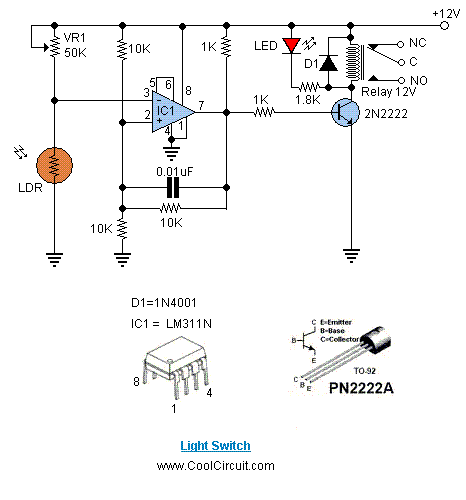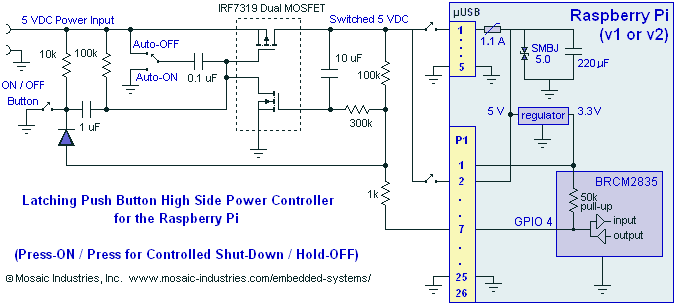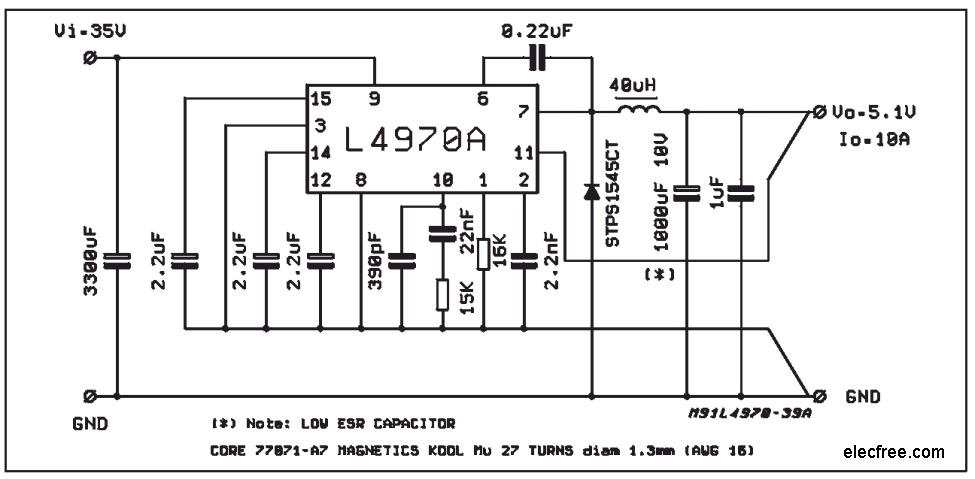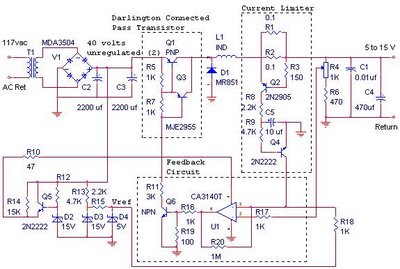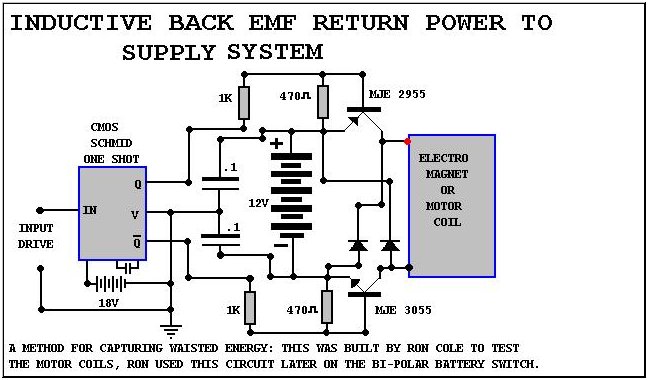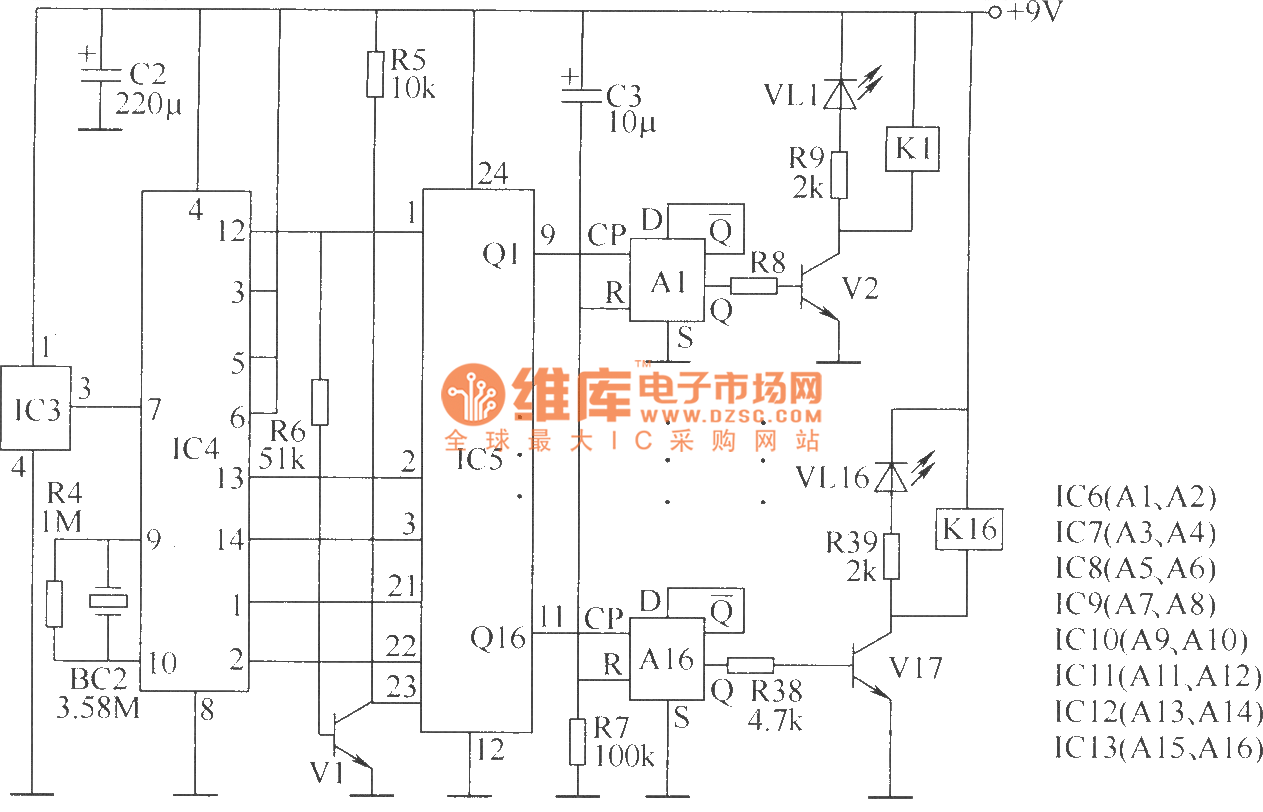
Four-Digit Keypad-Operated Switch
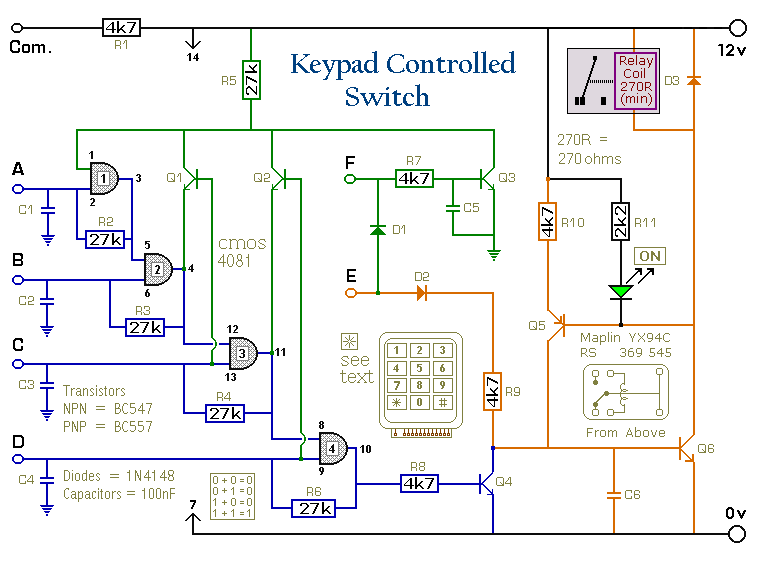
This is a universal version of the Four-Digit Alarm Keypad. The design of the output section has been modified to free up the relay contacts, allowing the circuit to function as a general-purpose switch. A single-pole changeover (SPCO) or single-pole double-throw (SPDT) relay has been used, although a multi-pole relay can be utilized if it fits the application. It is important to avoid using the onboard relay to switch mains voltage, as the board layout does not provide adequate isolation between the relay contacts and low-voltage components. For switching mains voltage, a suitably rated relay should be mounted in a safe location away from the board. The relay is activated by pressing a single key, which should be connected to terminal "E". Four keys designated for deactivating the relay should be connected to terminals "A", "B", "C", and "D". The common terminal should be connected to R1, while all other keys should connect to terminal "F". The circuit is straightforward to operate. Pressing "E" allows current to flow through D2 and R9, turning on Q6 and energizing the relay. The transistors Q5 and Q6 create a complementary latch, ensuring that the relay remains energized after the key is released. To deactivate the relay, keys "A", "B", "C", and "D" must be pressed in the correct order. When this sequence is completed, pin 10 of the integrated circuit (IC) goes high, activating Q4 through R8. Q4 connects the base of Q6 to ground, unlatching the complementary pair and causing the relay to drop out. Any keys not connected to "A", "B", "C", "D", or "E" are linked to the base of Q3 via R7. Pressing these incorrect keys causes Q3 to pull pin 1 low, resulting in a failed code entry sequence. If keys "C" or "D" are pressed out of sequence, Q1 or Q2 will also pull pin 1 low, yielding the same outcome. In case of an entry mistake, the user can simply restart the process. The keypad must feature a common terminal with separate connections for each key. A 12-key keypad should have 13 terminals, as the matrix type with 7 or 8 terminals will not be compatible. A 12-key keypad offers over 10,000 different codes, while a 16-key keypad provides over 40,000 codes for enhanced security. Support materials for this circuit include a step-by-step construction guide, a parts list, and a detailed circuit description.
The circuit operates on a straightforward principle, utilizing a keypad interface to control the state of a relay. The relay serves as an output mechanism for various applications, such as alarm systems or general-purpose switching tasks.
The circuit's design emphasizes safety and flexibility, allowing for different relay configurations based on the specific requirements of the application. The SPCO or SPDT relay configuration provides a reliable switching mechanism, while the option to use a multi-pole relay enhances the circuit's adaptability.
The implementation of a complementary latch using Q5 and Q6 ensures that the relay remains activated without continuous keypresses, providing a user-friendly interface. The requirement for pressing keys "A", "B", "C", and "D" in the correct order to deactivate the relay introduces a layer of security, preventing accidental deactivation and ensuring that only authorized users can control the relay.
The design also incorporates error handling through the feedback mechanism involving Q3, which monitors for incorrect key presses. This feature enhances the reliability of the system, ensuring that users are informed of any mistakes in the code entry process.
For applications requiring higher security, the use of a larger keypad with more keys wired to terminal "F" can significantly increase the number of possible codes, making unauthorized access more difficult. The circuit's scalability and adaptability make it suitable for a wide range of applications, from simple alarm systems to more complex control mechanisms in various electronic projects.
Overall, this Four-Digit Alarm Keypad circuit represents a versatile and secure solution for controlling relay operations while maintaining ease of use and adaptability for different applications.This is a universal version of the Four-Digit Alarm Keypad. I`ve modified the design of the output section - to free up the relay contacts. This allows the circuit to operate as a general-purpose switch. I used a SPCO/SPDT relay - but you can use a multi-pole relay if it suits your application. Do not use the "on-board" relay to switch mains volt age. The board`s layout does not offer sufficient isolation between the relay contacts and the low-voltage components. If you want to switch mains voltage - mount a suitably rated relay somewhere safe - Away From The Board.
The relay is energized by pressing a single key. Choose the key you want to use - and connect it to terminal "E". Choose the four keys you want to use to de-energize the relay - and connect them to "A B C & D". Wire the common to R1 and all the remaining keys to "F". The Circuit is easy to use. When you press "E" - current through D2 & R9 turns Q6 on - and energizes the relay. The two transistors - Q5 & Q6 - form a "Complementary Latch". So - when you release the key - the relay will remain energized. To de-energize the relay - you need to press keys "A B C & D" in the right order. When you do so - pin 10 of the IC goes high - and it turns Q4 on through R8. Q4 connects the base of Q6 to ground. This unlatches the complementary pair - and the relay drops out. Any keys not wired to "A B C D & E" are connected to the base of Q3 by R7. Whenever one of these "Wrong" keys is pressed - Q3 takes pin 1 low and the code entry sequence fails. If "C" or "D" is pressed out of sequence - Q1 or Q2 will also take pin 1 low - with the same result. If you make a mistake while entering the code - simply start again. The Keypad must be the kind with a common terminal and a separate connection for each key. On a 12-key pad - look for 13 terminals. The MATRIX TYPE with 7 or 8 terminals WILL NOT WORK. With a 12-key pad - over 10 000 different codes are available. If you need a more secure code - use a bigger keypad with more "Wrong" keys wired to "F". A 16-key pad gives over 40 000 different codes. The Support Material for this circuit includes a step-by-step guide to the construction of the circuit board, a parts list, a detailed circuit description and more.
🔗 External reference
The circuit operates on a straightforward principle, utilizing a keypad interface to control the state of a relay. The relay serves as an output mechanism for various applications, such as alarm systems or general-purpose switching tasks.
The circuit's design emphasizes safety and flexibility, allowing for different relay configurations based on the specific requirements of the application. The SPCO or SPDT relay configuration provides a reliable switching mechanism, while the option to use a multi-pole relay enhances the circuit's adaptability.
The implementation of a complementary latch using Q5 and Q6 ensures that the relay remains activated without continuous keypresses, providing a user-friendly interface. The requirement for pressing keys "A", "B", "C", and "D" in the correct order to deactivate the relay introduces a layer of security, preventing accidental deactivation and ensuring that only authorized users can control the relay.
The design also incorporates error handling through the feedback mechanism involving Q3, which monitors for incorrect key presses. This feature enhances the reliability of the system, ensuring that users are informed of any mistakes in the code entry process.
For applications requiring higher security, the use of a larger keypad with more keys wired to terminal "F" can significantly increase the number of possible codes, making unauthorized access more difficult. The circuit's scalability and adaptability make it suitable for a wide range of applications, from simple alarm systems to more complex control mechanisms in various electronic projects.
Overall, this Four-Digit Alarm Keypad circuit represents a versatile and secure solution for controlling relay operations while maintaining ease of use and adaptability for different applications.This is a universal version of the Four-Digit Alarm Keypad. I`ve modified the design of the output section - to free up the relay contacts. This allows the circuit to operate as a general-purpose switch. I used a SPCO/SPDT relay - but you can use a multi-pole relay if it suits your application. Do not use the "on-board" relay to switch mains volt age. The board`s layout does not offer sufficient isolation between the relay contacts and the low-voltage components. If you want to switch mains voltage - mount a suitably rated relay somewhere safe - Away From The Board.
The relay is energized by pressing a single key. Choose the key you want to use - and connect it to terminal "E". Choose the four keys you want to use to de-energize the relay - and connect them to "A B C & D". Wire the common to R1 and all the remaining keys to "F". The Circuit is easy to use. When you press "E" - current through D2 & R9 turns Q6 on - and energizes the relay. The two transistors - Q5 & Q6 - form a "Complementary Latch". So - when you release the key - the relay will remain energized. To de-energize the relay - you need to press keys "A B C & D" in the right order. When you do so - pin 10 of the IC goes high - and it turns Q4 on through R8. Q4 connects the base of Q6 to ground. This unlatches the complementary pair - and the relay drops out. Any keys not wired to "A B C D & E" are connected to the base of Q3 by R7. Whenever one of these "Wrong" keys is pressed - Q3 takes pin 1 low and the code entry sequence fails. If "C" or "D" is pressed out of sequence - Q1 or Q2 will also take pin 1 low - with the same result. If you make a mistake while entering the code - simply start again. The Keypad must be the kind with a common terminal and a separate connection for each key. On a 12-key pad - look for 13 terminals. The MATRIX TYPE with 7 or 8 terminals WILL NOT WORK. With a 12-key pad - over 10 000 different codes are available. If you need a more secure code - use a bigger keypad with more "Wrong" keys wired to "F". A 16-key pad gives over 40 000 different codes. The Support Material for this circuit includes a step-by-step guide to the construction of the circuit board, a parts list, a detailed circuit description and more.
🔗 External reference
Warning: include(partials/cookie-banner.php): Failed to open stream: Permission denied in /var/www/html/nextgr/view-circuit.php on line 713
Warning: include(): Failed opening 'partials/cookie-banner.php' for inclusion (include_path='.:/usr/share/php') in /var/www/html/nextgr/view-circuit.php on line 713
